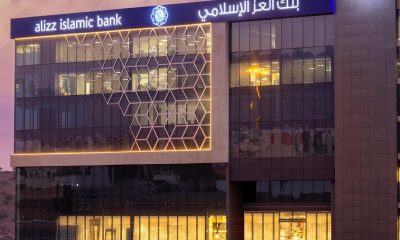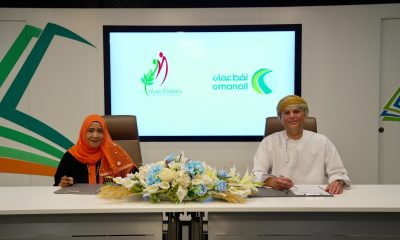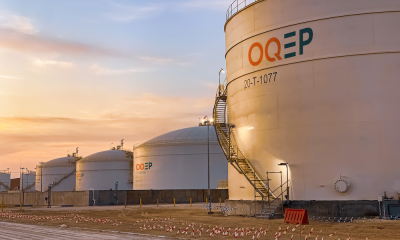Oman 2015
Robust Credit Growth
There has been a strong demand for credit from both segments — corporate and retail – which was contrary to general expectation.

There has been a strong demand for credit from both segments — corporate and retail – which was contrary to general expectation.
QUICK GLANCE
Robust demand for credit, especially for funding several mega projects, is supporting commercial banks.
The commercial banks achieved a reasonable 10.6 per cent growth in total credit at RO18.01 billion for the first eight months of 2015.
From an interest regime of around 6-7 per cent two years ago, the rates have dwindled.
Omani banks are expected to benefit enormously from the lifting of trade sanctions on Iran.
The Oman government has raised RO700 million so far this year by way of development bond and sukuk issues.
The sluggish trend in oil prices in the international market did not have much adverse impact on the country’s financial sector so far, if the credit growth is any indication. Robust demand for credit, especially for funding several mega projects, is supporting commercial banks. In fact, Omani banks started participating in funding several mega projects, which include industrial ventures and real projects. This has resulted in commercial banks achieving a reasonable 10.6 per cent growth in total credit at RO18.01 billion for the first eight months of 2015, from RO16.28 billion for the same period last year.
The incremental credit growth of all banks in absolute terms was RO1,725.9 million in a year, which is more or less in line with the loan growth seen last year and was mostly driven by both corporate and retails segments, the Central Bank of Oman data shows.
There has been a strong demand for credit from both segments — corporate and retail – which was contrary to general expectation. The demand for credit from the corporate sector is mostly for funding projects, since several mega projects are reaching implementation phase. Some of these projects are developed by state-owned entities like Oman Gas Company and Oman Oil Refineries and Petroleum Industries Company (Orpic). Orpic is implementing three major capital intensive projects — Sohar Refinery expansion, Liwa Plastics Project and a 230-km-long pipeline between Muscat and Sohar. Another major refinery and petrochemical project coming up in Duqm and a pipeline between Duqm and SaihNihayda are also expected to push demand for credit from financial institutions in the coming months.
All these shows that the pipeline of credit is still strong, which will continue for another two more quarters since local banks are also actively participating in syndicated loan facilities, along with their regional and international counterparts, for project funding. However, the growth in loan book was not fully reflected in the net interest income as also the bottom line since there is pressure on margins. With the oil price nearly halved compared to the previous year and government deposits with banks unlikely to happen in this quarter and a low interest regime, the coming quarter may see banks adopting a more cautious approach in credit disbursal.
The pressure explains why banks have been looking at new instruments and going in bonds and also rights issues. From an interest regime of around 6-7 per cent two years ago, the rates have dwindled and banks have been competing to offering personal loans at low levels. Personal loans account for the chunk of advances to retail customers, which is around 45 per cent share in the loan portfolio of banks.
Omani banks are expected to benefit enormously upon the lifting of trade sanctions on Iran. A number of opportunities for Oman banks will emerge, especially in the areas of trade finance and financing Oman industries, which seek to invest and expand their operations in the Iranian economy. The UAE and, Dubai in particular, is usually cited as the GCC country with the most to gain from Iran reconnecting with the world, but given the relatively warm political relations between Muscat and Tehran, coupled with the geographic proximity, there ought to be opportunities for Oman too. Iranian manufacturers are likely to view Oman’s special economic zones as an attractive location to establish plants. Similarly, Omani banks will have opportunities to support their customers’ Iran business development.
Among the GCC states, Oman is now the second largest importer of Iranian goods after the UAE, buying a quarter of all imports from Iran coming into the six-country bloc, according to the Kuwait Financial Centre. This presents an obvious foundation to build on. The most obvious sign of strengthening ties at the moment is the deal to build a $1billion sub-sea pipeline between the two countries so that Oman can import gas. Another route to strengthen the ties lies in some of Oman’s special economic zones, which are attached to its ports at Sohar, Duqm and Salalah. These offer an alternative to international companies wanting to service the Iranian market without sending their goods through the Strait of Hormuz to Dubai. Being the closest to Iran, Sohar is perhaps the most obvious jumping off point for the Iranian market, although Iranian investors were also among those in a delegation that visited Duqm Special Economic Zone in November. Oman’s banks appear ready to take advantage of any interest as soon as it emerges, particularly in areas such as trade finance. The lifting of Iranian sanctions is expected to significantly improve the already close relations between Oman and Iran. Further down the line, Omani banks may want to look at opening branches or representative offices in Tehran. For now none of the Oman banks have a presence in Iran, although two Iranian banks, Bank Melli and Bank Saderat Iran, have branches in the Sultanate.
The total deposits of Omani banks also rose by 5.78 per cent for the first eight months of 2015 at RO18.24 billion, from RO17.25 billion for the same period last year. The financial sector is likely to witness absorption of excess liquidity from the financial sector with Oman government raising debt funds to cover deficit in view of falling oil prices. The Oman government has raised RO700 million so far this year — RO300 million in July, RO200 million in February and RO200 million in February— by way of development bond and sukuk issues. The Sultanate’s government recently raised RO200 million by way of an Islamic bond or sukuk, which takes the total debt issue to RO700 million. The development bonds will help plug a projected RO2.5 billion deficit in the nation’s budget for 2015.
If government continues borrowing, bank liquidity will be tightened and the lending rates will not remain at the same level. The borrowing cost of banks will grow initially, which will cause a rise in lending rates of short-term maturities. If it is persistent, it will be reflected in lending rates of long-term maturities as well. Oman has seven conventional banks — Bank Muscat, National Bank of Oman, BankDhofar, HSBC Bank Oman, Bank Sohar, Oman Arab Bank and ahlibank. Among major banks, Bank Muscat posted a net profit of RO136.2 million for the nine months against RO126.7 million for the same period last year. Its net loans and advances from the conventional operation went up by 8.7 per cent to RO6.57 billion from RO6.04 billion. Deposits grew by 6.7 per cent to RO6.78 billion from RO6.35 billion.
BankDhofar posted a net profit of RO33.4 million, a 10.12 per cent rise from RO30.33 million for the same three quarters of last year. Net loans and advances grew by 16.83 per cent to RO2.64 billion from RO2.26 billion. Deposits went up by 15.96 per cent to RO2.55 billion during the period. National Bank of Oman posted a net profit of RO43 million, a 16 per cent rise from RO37.1 million. But deposits fell by 11 per cent to RO2.44 billion from RO2.72 billion. Loans and advances went up by 12 per cent to RO2.54 billion.
Bank Sohar had a net profit is RO21.29 million, indicating a 10.35 per cent fall compared to RO23.75 million last year. Its net loans and advances were up 17.69 per cent to RO1.67billion from RO1.42 billion. The Sultanate’s Islamic banks and window operations have shown a robust growth of 73.03 per cent in financing at RO1,449.2 million for the first eight months of 2015, from merely RO837.5 million in the same period last year. Such robust growth in Islamic finance shows that Sharia-compliant banks are able to establish themselves in the market and able to overcome their teething problems. Further, two Islamic banks and window operations of conventional banks have launched innovative products to attract Omani customers, besides opening several branches in different parts of the country.
Total customer deposits held by Islamic institutions also shot up by 208.14 per cent to RO1,234.70 million by the end of August 2015, from RO400.70 million for the same period last year, according to the latest monthly bulletin released by the Central Bank of Oman (CBO). There has been a considerable increase in the number of branches and assets held by these entities. Islamic banks are opening up new segments and, thus, adding to the competitive environment, not only in terms of efficiencies and innovations, but by also providing consumers the benefit of choosing between both conventional and Islamic banking products.
The total assets of Islamic banks and windows stood at RO1,870.6 million at the end of August 2015, against RO1,196.7 million for the same period of last year. Islamic banking entities provided financing of RO1,049.5 million as of the end of 2014, compared to RO434.3 million one year earlier. In Oman, two Islamic banks — Bank Nizwa and alizz islamic bank — along with the window operations of six conventional banks, have scores of branches across the country. Recently, an international rating agency has downgraded Omani banks’ issuer default rating. Fitch Ratings recently downgraded Bank Muscat’s long-term issuer default rating (IDR) to ‘BBB+’ from ‘A-’ and the same rating of National Bank of Oman, BankDhofar, Bank Sohar and Ahli Bank to ‘BBB’ from ‘BBB+’. The outlooks on all the banks’ long-term IDRs are stable. The downgrades follow a review of Fitch’s assessment of Oman’s ability to support domestic banks. At the same time, Fitch has affirmed HSBC Bank Oman’s IDR at ‘A+’ based on support from its ultimate parent, HSBC Holdings. The outlook has been revised to negative from stable. The downgrades reflect Fitch’s view that the Omani sovereign’s ability to support the banking system has weakened, said Fitch Ratings. Lower oil prices and higher-than-budgeted government expenditure have led to a major deterioration of Oman’s fiscal position.
The International Monetary Fund (IMF) estimates that the fiscal deficit will reach double digits, estimated at 14.8 per cent of gross domestic product (GDP) in 2015 and 11.6 per cent in 2016, from a deficit of 1.5 per cent in 2014. The scale of the budgetary shock highlights Oman’s dependence on hydrocarbons. Fitch forecasts an annual average oil price of $65 per barrel in 2015 and $75 a barrel in 2016. Oman’s sovereign balance sheet is strong, which mitigates pressures from lower oil prices. However, this position will deteriorate as sovereign wealth funds are drawn down. The IMF forecasts that, without further fiscal adjustment, these buffers would be exhausted by the end of the decade, assuming government debt is contained at 25 per cent of GDP. The IMF projects growth of 4.6 per cent in 2015, up from an estimated 2.9 per cent in 2014. The hydrocarbon sector will grow faster in 2015 as the government increases current oil expenditures to boost production and counteract lower oil prices. However, lower incremental returns from enhanced oil recovery techniques will slow oil production by 2016.

-

 OER Magazines2 months ago
OER Magazines2 months agoOER, September 2024
-

 Alamaliktistaad Magazines2 months ago
Alamaliktistaad Magazines2 months agoAl-iktisaad, September 24
-

 Uncategorized1 month ago
Uncategorized1 month agoOman Oil Marketing Company partners with Ihsaan Association to support its activities
-

 Commodities1 month ago
Commodities1 month agoGold Rangebound as Investors Brace for Key US Economic Data
-

 Banking & Finance2 months ago
Banking & Finance2 months agoApple Pay Officially Launched in Oman
-

 Oil & Gas1 month ago
Oil & Gas1 month agoOQEP Appoints United Securities as Liquidity Provider Ahead of Landmark MSX Listing
-

 Lifestyle1 month ago
Lifestyle1 month agoRoyal Opera House Muscat Welcomes First Shows of its 2024/25 Season
-

 OER Magazines2 weeks ago
OER Magazines2 weeks agoSignature, October 24



























You must be logged in to post a comment Login